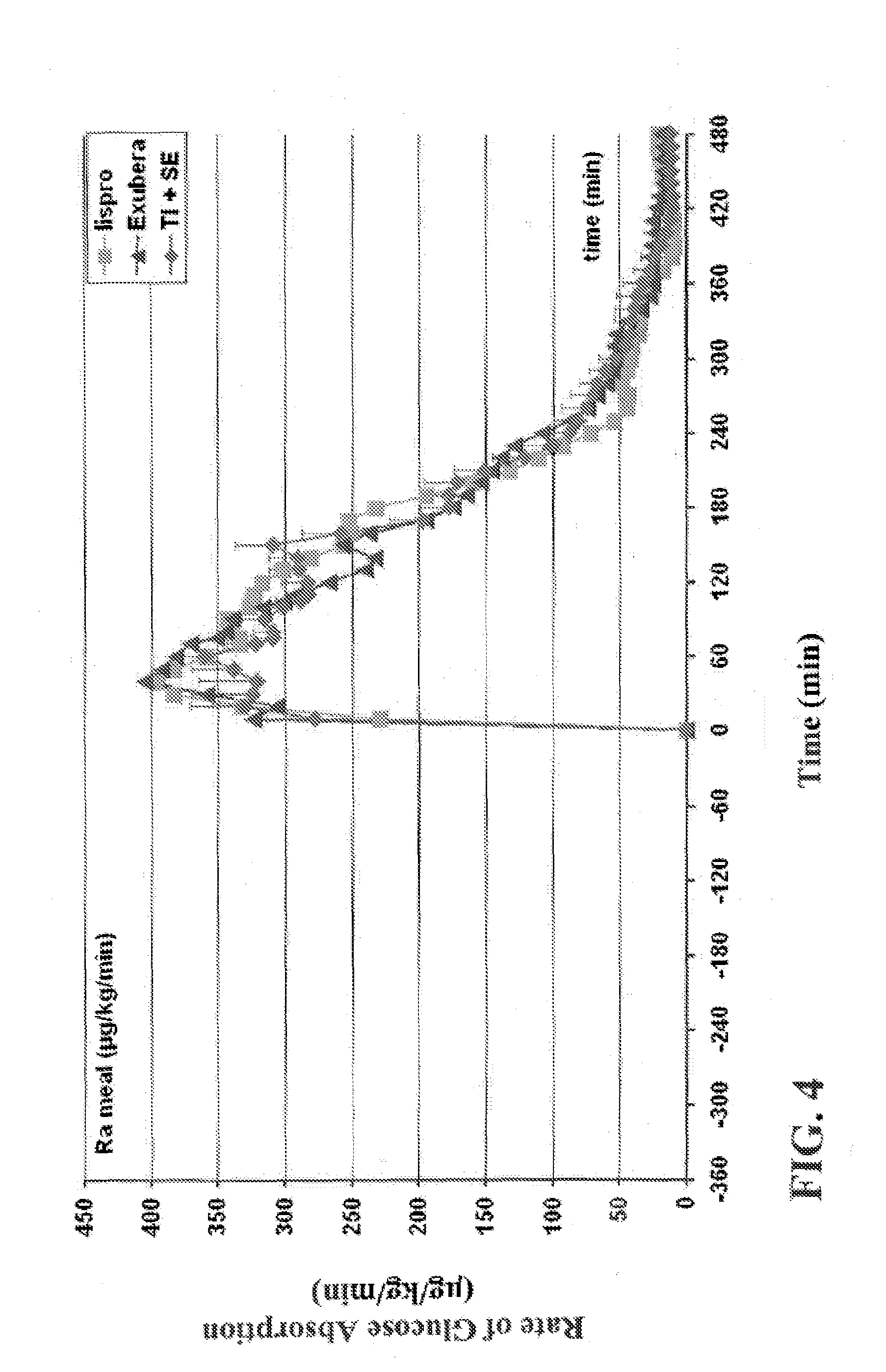Use of ultrarapid acting insulin
- Summary
- Abstract
- Description
- Claims
- Application Information
AI Technical Summary
Benefits of technology
Problems solved by technology
Method used
Image
Examples
example 1
[0204]The experiments were conducted to identify the effect of an ultrarapid acting insulin, specifically a formuslation for inhalation comprising insulin-FDKP, when compared to subcutaneously administered insulin lispro (lispro, HUMALOG®, Eli Lilly & Co.) and an inhaled recombinant human insulin (EXUBERA®, Pfizer Inc.) on endogenous glucose production after a meal challenge and during a euglycemic glucose clamp procedure in subjects with type 2 diabetes. The insulin-FDKP formulation is administered to the subjects by oral inhalation using a MEDTONE® dry powder inhaler (MannKind Corp.).
[0205]Following the completion of the meal challenge, the data was analyzed as per the statistical analysis plan. Total insulin exposure was found to be approximately 40% greater following the administration of 12 U lispro than following either 45 U insulin-FDKP (TI) or 4 mg EXUBERA®. Hence, the study was redesigned, and subjects did not proceed to the euglycemic glucose clamp portion of the study und...
example 2
A Prospective, Multi-Center, Open-Label, Randomized, Controlled Clinical Trial Comparing the Efficacy and Safety in Subjects with Type 1 Diabetes Receiving SC Basal Insulin and Prandial Inhalation of Insulin-FDKP Versus SC Basal and Prandial Insulin Over a 52-Week Treatment Period and a 4-Week Follow-Up
[0228]This was a prospective, multi-country, multicenter, open label, randomized, controlled clinical trial comparing glycemic control in subjects with type 1 diabetes receiving basal insulin and prandial insulin-FDKP (TI) Inhalation Powder (TI Inhalation Powder group) with subjects receiving basal insulin and SC rapid-acting insulin aspart (comparator group). This study included a 52-week treatment phase and a 4-week follow-up phase. During the 4-week follow-up phase, pulmonary function and select clinical laboratory assessments were scheduled.
[0229]The study began with enrollment at Week −3. Subjects received a complete battery of safety and eligibility assessments, including HbA1c ...
example 3
A Prospective, Multi-Center, Open-Label, Randomized, Controlled Clinical Trial Comparing the Efficacy and Safety in Subjects With T2 DM Receiving SC Basal Insulin and Prandial Inhalation of TI Vs. SC Premixed Insulin Therapy Over a 52-Week Treatment Period and 4-Wk Follow-Up
[0249]This trial compared the efficacy as expressed by change in HbA1c over a 52-week period of prandial administration of TI Inhalation Powder in combination with basal insulin therapy (TI group) versus a premix of intermediate-acting and rapid-acting insulin (comparator group) in subjects with suboptimally controlled type 2 diabetes, previously treated with regimens of sc insulins±oral anti-hyperglycemic agents. The reduction in HbA1c was comparable between TI+basal insulin and premixed insulin. The percent of responders for an end of study HbA1c≦7.0% was comparable and not statistically different between the TI+basal insulin and premixed insulin groups. Notably fasting blood glucose was reduced significantly b...
PUM
| Property | Measurement | Unit |
|---|---|---|
| Mass | aaaaa | aaaaa |
| Weight | aaaaa | aaaaa |
| Electrical resistance | aaaaa | aaaaa |
Abstract
Description
Claims
Application Information
 Login to View More
Login to View More - R&D
- Intellectual Property
- Life Sciences
- Materials
- Tech Scout
- Unparalleled Data Quality
- Higher Quality Content
- 60% Fewer Hallucinations
Browse by: Latest US Patents, China's latest patents, Technical Efficacy Thesaurus, Application Domain, Technology Topic, Popular Technical Reports.
© 2025 PatSnap. All rights reserved.Legal|Privacy policy|Modern Slavery Act Transparency Statement|Sitemap|About US| Contact US: help@patsnap.com



